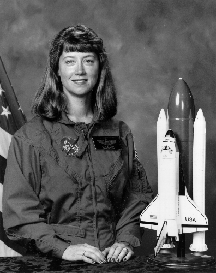 Read
Next Article in Newsletter
Read
Next Article in Newsletter

Summer, 1998
A publication of the Minnesota Space Grant Consortium
MnSGC Sponsors First Annual Space Science Across
the Curriculum Conference
Second Annual Solway Rocket
Shoot in Bemidji a Blast for Kids
NASA
Academy Accepts Record Three MnSGC Students in '98
Bethel
College Hosts Second Annual Undergraduate Research Symposium
Augsburg
College Hosts Sverdrup Lecture on Marine Life
Upcoming
Events
Consortium
Affiliates
The first annual Space Science Across the Curriculum Conference was held February 21, 1998 at the Science Museum of Minnesota, co-sponsored by the Minneapolis Planetarium and the Minnesota Space Grant Consortium (MnSGC). 38 teachers from Minnesota and Wisconsin attended over twelve workshop sessions that targeted hands-on Across the Curriculum content and were aligned with the National Science Standards and Minnesota Graduation Rule. Keynote speaker, astronaut Lt. Col. Pamela Melroy, was greeted with enthusiasm by conference attendees and the general public.
Workshop presentations included: Computer Image Processing, Larry Mascotti, Mayo Sr. High; Shuttle Payloads, Steve Brehmer, Mayo Sr. High; Integrating Space Science Across the K-4 Curriculum, Jeannine Gregoire, Augsburg College; Satellite Observing, Rod Nerdahl, Minneapolis Planetarium; Moonrock Certification, Ralph Winrich, NASA LeRC; NASA Educational and Development Program, Curt Olson, Sauk Rapids Sr. High; Planetary Terraforming, Brad Blue, Marcy Open; Aviation Literature, Cheryl Young; Rocketry Software, Terry Flower, College of St. Catherine; Launch Resources and Contextual Activities, M.J. Savaiano, Barton Open; Mission Mathematics, Mary Jo Aiken; Toys That Teach, Ollie Kaldahl, U of M.
The workshop closed with Native American Storyteller, Duke Addicks who chronicled the Northern American and European heritage on skylore. The Space Science Across the Curriculum Conference will be held again March 13, 1999 at the Science Museum of Minnesota.
Lt. Col. Melroy (pictured, below) was featured as the keynote
speaker at the Space Science Across the Curriculum Conference with her
presentation, “Training to Fly in Space.” Lt. Col. Melroy will pilot
the STS 92 in January, 1999.


The above photo was taken at the Summer Explorations in Science, Engineering & Mathematics (SESEM) program for high school students that was held June 16-July 22 on the University of Minnesota (U of M) campus. The U of M Institute of Technology (IT) provided teens with a strong interest in math and science the opportunity to work directly with IT faculty to explore topics in science, engineering, and mathematics at the college level. Participants were enrolled in an IT calculus summer course and introduced to the applications of calculus through exposure to current laboratory research. The research topics covered included the movement of Jupiterís moons, aerodynamics and thrust of rockets, molecular engineering and chemistry, computer chip technology, mining and geology, voice digitization and modern communication. The students received college credit from IT for the course. Jerry Brenden, an Aerospace Engineering and Mechanics (AEM) graduate student (pictured above, far right) and Dr. Bill Garrard, Professor and Head of the Department of Aerospace Engineering, facilitated the AEM rocketry session for SESEM.
NASA Academy Accepts Record Three MnSGC Students in '98
Every year junior and senior undergraduates from across the MnSGC apply for sought-after internships with the NASA Academy Program. This year was no exception and the MnSGC is pleased to announce the 1998 awardees.
Wendy Davis, physiology and psychology major at the U of M, is attending the Ames Academy in Moffett Field, CA. Wendy is working with Dr. Patricia Cowings on the “Psychophysiological Studies of Altered Gravitational Effects on Human ANS and CNS Function.” Wendy is one of 15 students working at the Ames Astrobiology Academy where she will gain a working knowledge of NASA’s programs, technical experience in a world-class laboratory, and fraternal teaming experience that demonstrates the power of people working together.
Emily Eelkema, majoring in Aerospace Engineering and Mechanics at the U of M, is at the NASA Dryden Flight Research Center at Edwards Air Force Base in Edwards, CA. Emily is working Dr. John Bosworth on the Model F-16XL to act as a testbed for the automatic landing system of the X-33 and on stability analysis of the landing trajectory of the X-38.
Jim Chase, Aerospace Engineering and Mechanics major at the U of M,
is at Goddard Space Flight Center in Greenbelt, MD. Jim is working
with Dr. David Buhl on an automated laser control and monitoring system.
In order to amplify an infrared signal from Jupiter to measure atmospheric
wind, astronomers must use a very precise laser frequency which Dr. Buhl
would like to be able to mount on a Boeing 727 or a satellite, to be monitored
from a distant location. Jim is helping to develop a control for
the laser.
All 23 Goddard Academy participants will also complete a group project
to study the feasibility of sending a small (50kg) satellite to impact
on the moon inexpensively.
At all of the Academy sites, participants are involved in supervised research and team-building activities and are exposed to a variety of people involved in space science. Jim says, "The speakers have been fantastic. We have heard from a variety of directors, scientists, company presidents, policy makers, education directors, and business people. My favorites have been Dr. Julius Dasch (who led an antarctic team and discovered a lunar meteorite) and Dr. Diamands (who started the X-prize foundation, SEDS, and others)." The Academy doesn't leave much time for play, but Jim has managed to find time to go spelunking and white-water-rafting anyway.
Academy applications are available every January in the MnSGC
Office or on the NASA Academy website.